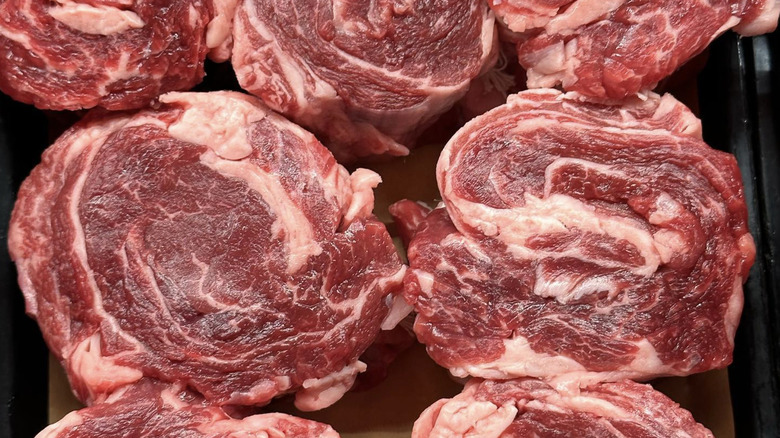Ribeye Caps Are The Underrated Cut Of Meat You Need To Start Grilling
Steaks are the joy of any meat-eater. Whether you prefer the fatty juiciness of a ribeye, the tender lean meat of a filet mignon, or the familiar flavor of New England steak tips, if you enjoy beef, maybe no meal is finer than a steak, especially grilled.
There are more cuts of beef than we can name, and you might not be familiar with some of them. If you're a connoisseur, you might be familiar with some of these lesser-known cuts: The hanger steak is also known as the "butcher's steak" because butchers used to keep it for themselves, while the tri-tip provides tremendous value as a great cut for a cheap price. But there's another cut in the same category you should really try out: the ribeye cap. When cooked correctly, this flavorful cut is one of the most tender pieces of meat on the entire cow. It's just down to knowing what to do with it.
What is a ribeye cap steak?
Ribeyes are highly prized among steak aficionados for their juiciness and full, robust flavor. The slightly chewy texture of their meat might not be for everyone, but there's a reason fans of steak have a particular liking for them. But within a ribeye, there always seem to be a few bites that are unusually tender and pack an enormous flavor punch. This special part of the steak is the spinalis dorsi muscle, also known as the ribeye cap steak (or deckle steak).
Unfortunately, there are two problems with ribeye caps. First, they're not very big; each one is only about a few bites. Second, to get at them, a butcher basically has to "ruin" the ribeye to get at them. This doesn't mean the meat that's left over is inedible — it's still perfectly good. But it's a lot harder to sell what's left of the ribeye when that secondary cut isn't nearly as good as the prized cap. But if you can get ribeye caps, the rewards are well worth it — as long as you know what to do with them.
The key with a ribeye cap steak is to hit it with high heat
There's a reason why grilling is the preferred method for cooking this steak; it's a fatty, tender cut, meaning it goes best with high heat. Unlike something loaded with connective tissue like brisket, which needs to be cooked slowly (and which you never want to grill), ribeye caps take well to fast, high heat that melts and renders the fat within. You have to make sure you don't overdo it, though; because it's fatty and tender, this isn't a cut that takes well to being overcooked. If you're a well-done steak person, you should probably avoid this cut (and ribeyes in general).
As long as you treat it right, though, the spinalis dorsi muscle will treat you right in return. It's like any other culinary endeavor; you just have to know how to work with the product at hand.


